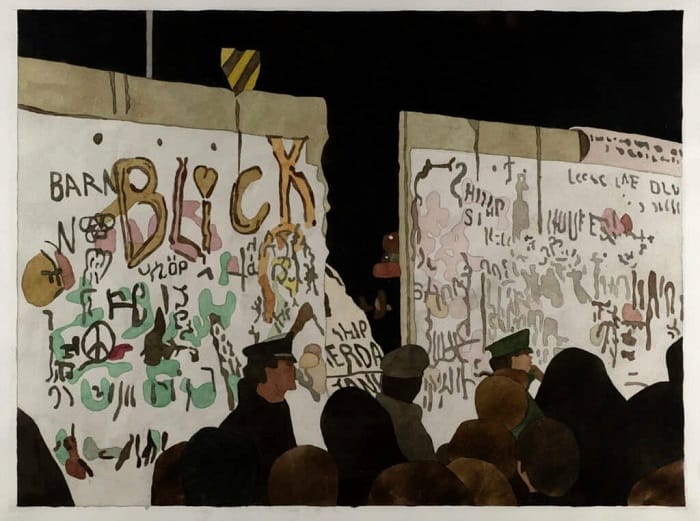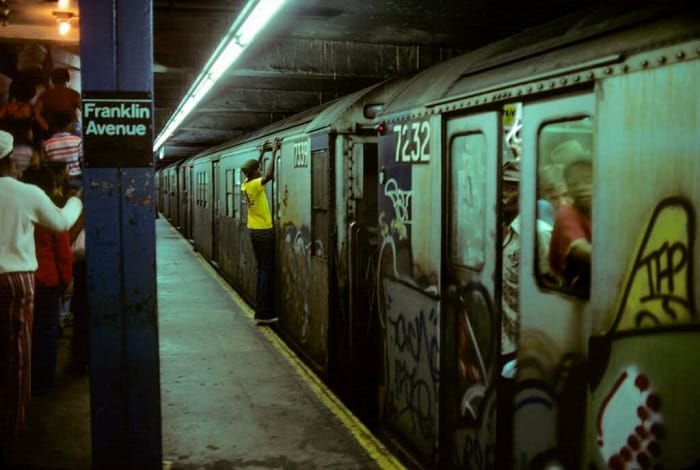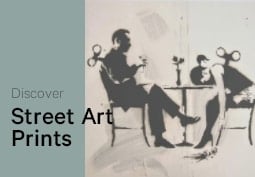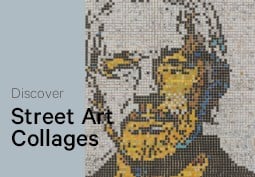Articles and Features
Street Art: History of the Art Movement and the Artists That Turned Cities Into Open Sky Museums
By Adam Hencz
“I don’t think about art when I’m working. I try to think about life.”
Jean-Michel Basquiat
Street art is regarded as one of the largest art movements that has achieved huge popularity and is still rapidly growing as an art form. Street artworks mainly appear in urban areas and public locations such as exterior walls of buildings, highway overpasses and bridges, and remarkably define the outlook of many neighborhoods and cities all around the world. Reflections on political and social issues are often central to street art which varies from sprayed tags, through stickers and knitted fibers wrapping telephone poles to monumental painted murals covering entire buildings. Street art, to a certain extent, is connected to and encompasses graffiti art.
Key dates: ca. 1960s – ongoing
Key regions: originated from the metropolises of the United States, especially New York City and Philadelphia, now spread around the world
Keywords: graffiti, subway art, guerilla art, public art, urban art, large scale murals
Key artists: Keith Haring, Jean Michel Basquiat, Cornbread, Banksy, Shepard Fairey, Lady Pink, Blu
Key characteristics: created in public spaces with a strong political or social message

The History of Street Art
People have been using natural surfaces to draw and paint on them since prehistoric times when handprints and paintings depicting hunting scenes were put on cave walls to evoke the prosperity and unity of small human communities. What we call street art today is inherently different from the aforementioned wall writings and dates back to modern times, to the war of infamous gangs of New York City in the 1920s and 1930s, when name-based tags and primitive graffiti started popping up on the streets, marking controlled territories by the gangs. A similar urban climate contributed to art murals finding their way into the cityscapes of Southern California’s metropolises around the same time. Well-documented origins of street art come from Philadelphia and especially New York City. In the 1960s, New York was going through hard times and was on the brink of bankruptcy. The vast areas of boarded-up buildings, vacant lots, closed down factories and construction sites became the canvas for a group of creative kids, first in Spanish Harlem, that led to the development of a whole art form that went from a simple signature all the way to murals that covered entire subway cars.

The New York Golden Age
The mid-1970s saw the evolution of different styles as many seminal street artists at that time would write their nicknames and pseudonyms in a unique manner with an original design, battling the quest to get noticed. Only a few artists captured the creative process and the early momentum of street artist communities, photographer Martha Cooper being one of the most respected names to do so. She started documenting the New York street art scene and street artists in the 1970s, and also largely contributed to the development of the whole movement by distributing her book called Subway art, published in the early 1980s. Cooper’s slim paperback edition quickly became a style guide for train writers and graffiti artists not only across the United States but in Europe as well.
During the 1980s, street and graffiti art found their way into art galleries and museums, at a time when artists like Keith Haring and Jean-Michel Basquiat from the New York street art scene gave credibility to such realm and took their works from the street into the fine art world. Since then, the art form has secured its position in the art world and become validated as a cultural phenomenon, even though such practices are considered illegal in many cities around the world.
Themes & Techniques of Street Art
Often humorous and thought-provoking, Street Art covers an extreme wide range of themes and interesting techniques beyond the traditional graffiti and spray paint.
Themes
Whilst territorial and rebellious in nature, street art tends to convey a social or political message that provokes discussion and reaction. Street art is often connected to activism that creates awareness about pressing social and environmental issues.
Techniques
Street art is created in a vast variety of ways with a wide range of techniques. Tagging by aerosol paint is one of the most common and quickest ways to put out a work in public, while markers, paint, and innovations such as filling fire extinguishers with paint are also widely used. However, street art is not limited to paint and markers, as artists are using absolutely any kind of material and medium available such as stencils, stickers, posters, textiles, LED lights, mosaics or video projection. Yarnbombing, the act of taking colorful knitted or crocheted yarn or fiber to the streets, is one of the fairly new phenomena in the street art world.
Graffiti vs Street art
Drawing the line between graffiti and street art can be difficult. The most obvious distinction is in intent. While street art is often commissioned, making graffitis is typically sanctioned and cities often treat the act of spraying graffiti as vandalism. Another distinctive feature of the two is that street art contains elements connected to graphic design and is more about imagery, while graffiti always has a text-based subject in the act of tagging and lettering. Graffiti art is largely associated with hip hop as well as punk subcultures and still represents a form of rebellion it is synonymous with.
Most famous Street Artists
We take a look at some of the most famous street artists of the past and the most influential street artists of the present day.
Banksy
Despite his international fame, the identity of stencil-artist Banksy is still shrouded in mystery. An enigma himself, Banksy got noticed for spray-painting trains and walls in his home city of Bristol in the 1990s. Since then, the artist became a worldwide phenomenon, putting subversive and controversial messages on the streets all around the world. He also pulled off one of the most original auction stunts in art history, when his 2006 painting of Girl with Balloon unexpectedly self-destructed immediately after it was sold for more than a million dollars at a Sotheby’s auction.
Keith Haring
Keith Haring played a significant role in the rise of the 1980s New York street art scene, creating graffiti-inspired paintings and drawings that broke down the barriers between street culture and high art. Haring found a unique way to participate in the city’s creative boom, using his own visual language and symbols to comment on issues like drug addiction, sexuality, war and power. He first gained popularity in the early 1980s with his cartoon-like subway drawings, which were temporary works he would create with a piece of chalk using blank advertising posters at subway stops as his canvas.
Jean Michel Basquiat
Born to a Puerto Rican mother and a Haitian immigrant father, Jean-Michel Basquiat, like many of his contemporaries, began his work on the streets of New York City. At the age of 20, he began working on paper and canvas in a so-called consolidated way, while studying art history on his own. He befriended his idol, Andy Warhol, who not only did a lot for his advancement and recognition but also collaborated with Basquiat. Basquiat struggled with the sudden fame and pressure for years in an escalation that resulted in a heroin overdose at the age of 27. After his early death, his reputation has soared and today, through his paintings and graffiti, Jean-Michel Basquiat is considered as one of the first and greatest exponents of visual art in the history of African American art.
CornBread
CornBread, also known as Darryl McCray is widely considered as the world’s first graffiti writer and artist, living and working in Philadelphia. He started doing graffiti in the 1960s and helped put graffiti art into a contemporary context. He is a graffiti icon who works as a public speaker as well as a youth advocate.
Shepard Fairey
Shepard Fairey is a contemporary American street artist, who founded the well-known brand OBEY, which emerged from the skateboarding scene. Besides stencil works, Fairey creates murals as well as graphic illustrations and designs. He is the creator of former US president Barack Obama’s successful 2008 campaign logo and “Hope” poster.
Lady Pink
The Ecuadorian-American painter, muralist and graffiti writer Lady Pink became a cult figure in the 1980s hip hop and graffiti scene, first getting noticed in the late 1970s for her subway train paintings. Throughout her career, she used graffiti as an act of empowering women and continues to mature as an artist, creating monumental works around New York as well as holding mural workshops for local communities.
Blu
Blu from Bologna, Italy, represents a younger generation of street artists. He is known for his ambitious projects and politically-charged epic-scale murals. His best-known project is MUTO, a blend of street art and stop-motion animation. In 2016, he systematically erased and destroyed 20 years worth of murals he created on the streets of Bologna as a form of protest against the oppression of youth culture in the city.
Relevant sources to learn more
Discover and buy Street Art on Artland
Read more on Street Art on the Artland Magazine
Coronavirus Street Art: How The Pandemic Is Changing Our Cities
Supporting The Protest. Street Artists Across the Globe Pay Tribute to George Floyd With Dazzling Murals
10 Poignant Works of Street Art Around The World in Support of Ukraine
Check out STRAAT: the museum of street art and graffiti






